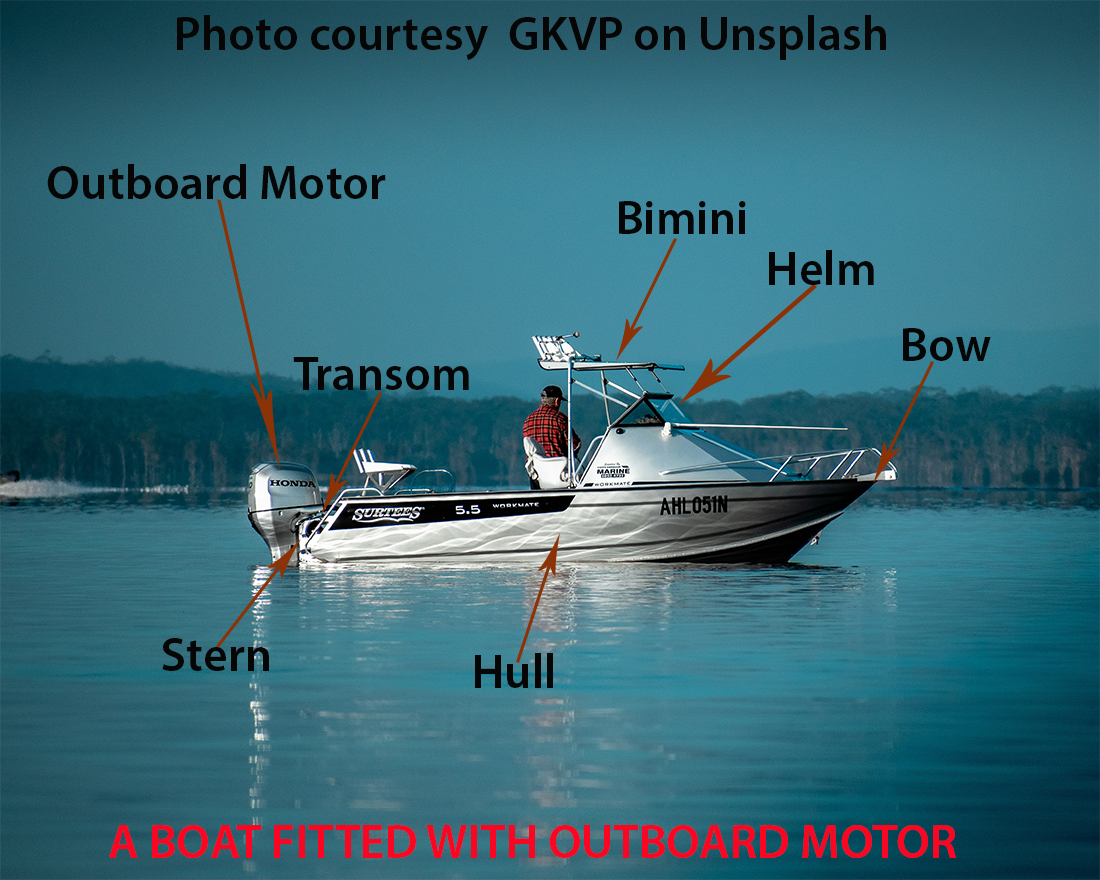Introduction
If you are a person interested in boating as a hobby or if the area you live in involves regular commuting by boat, a knowledge of the parts and terminologies of a boat can be helpful. If you want to refer to a boat service manual or communicate with a fellow sailor or boat mechanic, a knowledge of the parts and terminologies of a boat will be handy.
This article concentrates on the parts and terminologies of small and big boats and most of them apply to ships also.
Parts of a boat and anatomy of a boat
Car drivers use phrases like driver side to indicate the side where the driver sits, passenger side to indicate the side where the passenger sits on the front seat, engine end (front of the car), rear end (luggage end), and so on.
But boats and ships have terminologies and names of the parts that are used and understood universally by sailors all over the world. A knowledge of parts and terminologies used for boats and ships may be useful even for non-boaters.
For the sake of convenience, we can discuss the parts of a boat under two heads:
- Parts of a boat (where the parts exist physically on a boat)
- Terminologies of a boat (terminologies used by sailors; it can be a dimension or information concerning a boat)
Parts of a boat
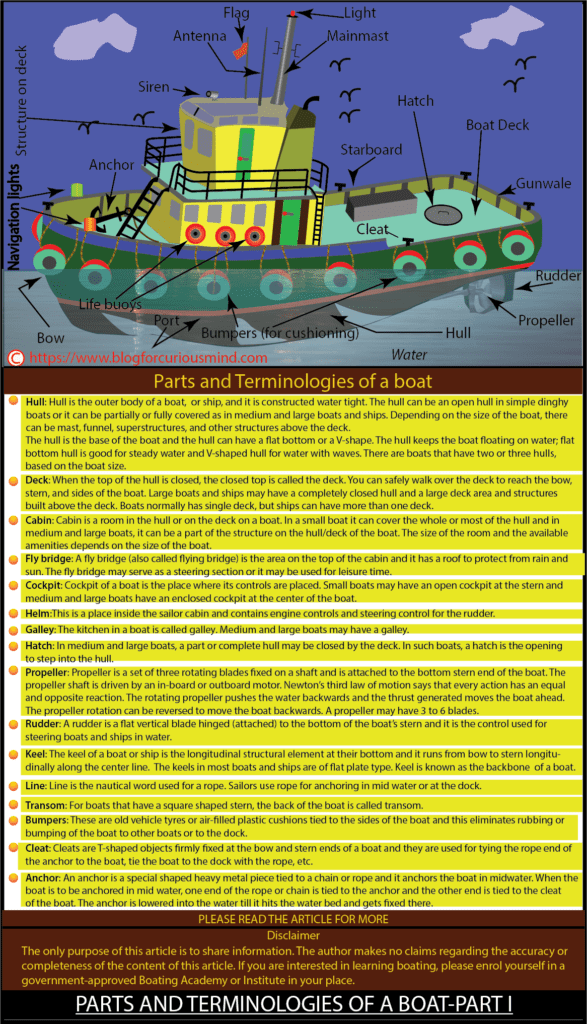
Hull
The hull is the outer body of a boat or ship, and it is constructed watertight. The hull can be an open hull in simple dinghy boats or it can be partially or completely covered as in the case of medium and large boats, and fully covered as in ships.
You can say that the hull is the base of the boat and the hull can have a flat bottom or a V-shape. The hull keeps the boat floating on the water; a flat bottom hull is good for steady water and a V-shaped hull for water with waves. Some boats have two or more hulls.
A hull protects what is inside it, including humans, boat accessories, personal belongings, cargo, etc. The construction of the hull should be watertight and its shape should minimize the drag offered by water to the boat.
The shape and cross-section of the hull can vary based on the type of boat; a speed boat has a thin section designed aerodynamically for speed and the hull of a cargo boat is built strong with thick sections.
Bow
The front of the boat or ship is called the bow and the shape of the bow assists the boat to cut through the wavy water, deflect waves, and prevent the boat from getting flooded with water and drowning. The shape of the bow and its height can reduce the drag offered by the water to the moving boat and minimize the water splashing into the boat. The space in the bow is used for storing essential equipment like an anchor. You can say a bow is the forward end of a boat. The shape of the bow can be pointed in high-speed boats and it can be rounded and solid in ships that navigate in turbulent waters.
Stern
Stern is the opposite end of the bow or it is the rear end of a boat. Based on the type of boat you have, the stern end can be of square or pointed shape (a square stern is called a transom, and a pointed stern is a canoe). You can say the stern is the aft end of a boat. The propulsion system of a boat is located at its stern.
Port and starboard
When you are standing on the deck of a boat facing the bow, the side to your left is called port and the side to your right is called starboard.
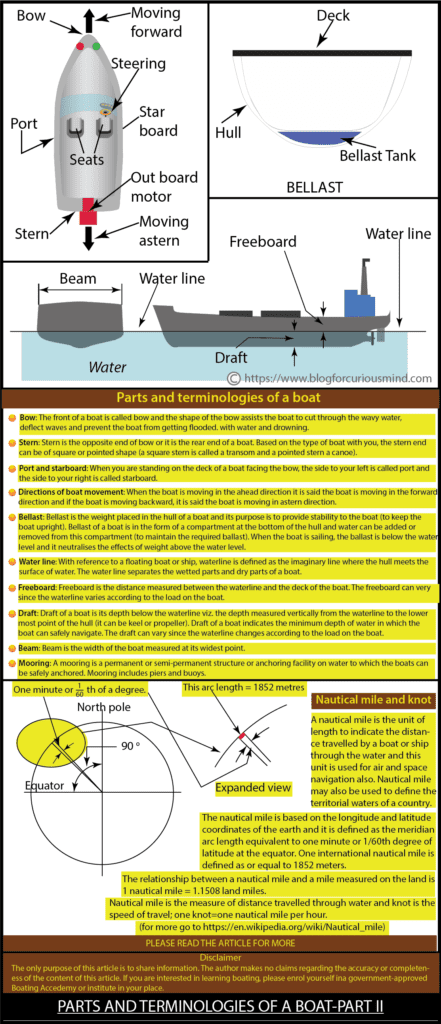
Forward and aft
The area at the bow of the boat is called forward and the area at the stern of the boat is called aft. Forward is the frontmost area at the bow and aft is the area at the stern.
Deck
When the top of the hull is closed, the closed top is called the deck. You can safely walk over the deck to reach the bow, stern, and sides of the boat. Large boats and ships may have a completely closed hull and a large deck area. Such boats and ships have structures built above the deck for the use of sailors manning the boat or ship, and living space for crew and passengers.
Depending on the size and type of boat, the deck covers the hull partly or completely; there can be a mast, funnel, superstructures, and other structures above the deck. Boats normally have a single deck, but ships can have more than one deck.
Cabin
A cabin is a room in the hull or on the deck of a boat. In a small boat it can cover the whole or most of the hull and in medium and large boats, it can be a part of the structure on the hull/deck of the boat.
The size of the room and the available amenities depend on the type and size of the boat. In large boats, the cabin can extend above the deck and can contain many rooms like a kitchen, dining, berths for sleeping, and bathrooms, and they can be luxurious.
Flybridge
A flybridge (also called a flying bridge) is the area on the top of the cabin and it has a roof to protect it from rain and sun. The fly bridge may serve as a steering section or it may be used for leisure time.
Cockpit
The cockpit of a boat is the place where its controls are placed. Small boats may have an open cockpit at the stern and medium and large boats have an enclosed cockpit at the center of the boat.
Helm
This is a place inside the sailor cabin and contains engine controls and steering control for the rudder.
Galley
The kitchen in a boat is called a galley. Medium and large boats may have a galley.
Hatch
In medium and large boats, a part or complete hull may be closed by the deck. In such boats, a hatch is the opening to step into the hull.
Funnel
A funnel is used for releasing the exhaust gasses of the engine into the atmosphere. You may find a funnel only on large boats that run on an inboard engine.
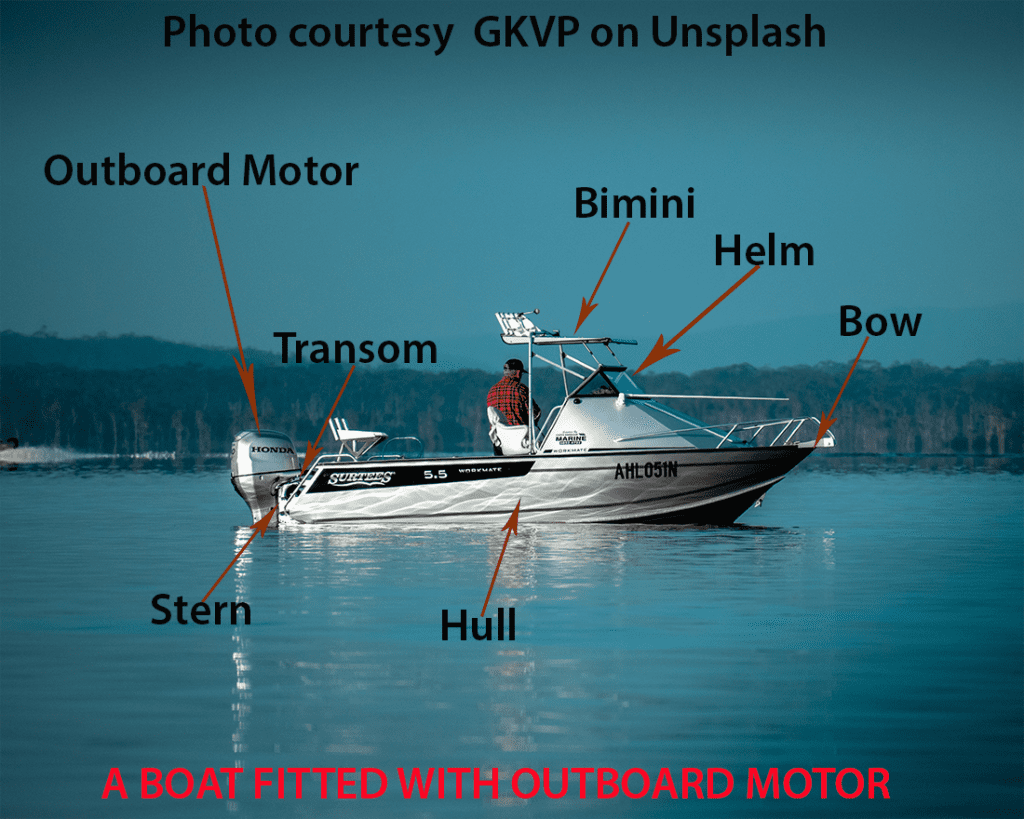
Propeller
A propeller is a set of three rotating blades fixed on a shaft and is attached to the bottom stern end of the boat. The propeller is submerged underwater and it rotates to move the boat forward and backward. A propeller has three parts, a propeller shaft, a hub, and blades welded to the hub and it is driven by an inboard or outboard engine.
Newton’s third law of motion says that every action has an equal and opposite reaction. The face of the propeller blades is designed in such a way that the rotating propeller pushes the water backward and generates the forward thrust required to move the boat ahead. A propeller may have 3 to 6 blades. The rotation of the propeller can be reversed to move the boat backward.
Rudder
A rudder is a flat vertical blade hinged (attached) to the bottom of the boat’s stern and it is positioned after the propeller. The rudder is the control used for steering boats and ships in water. In small boats, the rudder is operated by the helmsman using a tiller, and in large boats and ships, the rudder is connected to the steering wheel through cables or hydraulics.
A rudder works by redirecting the water to give a turning motion to the boat. When the rudder blade is straight, the boats move ahead on a straight path. The helmsman tilts the rudder towards the left or right to change the path of the boat (to make a turn).
Keel
The keel of a boat or ship is the longitudinal structural element at its bottom and it runs from bow to stern longitudinally along the center line of the boat or ship. Keel is said to be the first step in the construction of the hull of a boat or ship. The keels in most boats and ships are of flat plate type. The keel is known as the backbone and base of a boat and ship.
The keels of sailboats have different shapes (fin shape), and they have two functions (i) minimizing the lateral movement of the sailboat and (ii) fin-type keel uses the forward movement of the boat to provide a lift to it and this increases the speed of the boat.
Line
Line is the nautical word used for a rope. Sailors use rope for different purposes including anchoring in mid-water or at the dock. Sailors use different types of knots to tie the rope to the anchor, cleat, or to another boat.
Bimini
A Bimini is the roof over the deck to protect the boaters from sun and rain. A Bimini may be made of fabric or other material and it may be of retractable type. All boats will not have Bimini. Some boats may not have any protection from sun and rain and medium and large boats may have permanent structures.
Transom
For boats that have a square-shaped stern, the back of the boat is called a transom. A transom joins the left and right sides of the hull.
Livewell
Live well is a section on a fishing boat typically constructed for storing the fish bait and keeping the fish caught alive till they are back to shore. The special section has a system to maintain the oxygen levels to keep the fish alive. Live well serves fishers who want the fish to be fresh when they are back at shore or people who want to release the fish back into the water later.
Bumpers
These are old vehicle tires or air-filled plastic cushions tied to the sides of the boat and this eliminates rubbing or bumping of the boat to other boats or to the dock.
Cleat
Cleats are T-shaped objects firmly fixed at the bow and stern ends of a boat and they are used for tying the rope end of the anchor to the boat, tying the boat to the dock with the rope, etc.
Bilge
Bilge is the lowest part of the boat’s hull and water for different reasons can be accumulated in this area; the reasons are water splashing during sailing, rainwater, water spilled by the boat occupants, etc. For the safety of the boat and its occupants, the water in the bilge above the specified level is to be emptied and this is done by a submergible bilge pump in medium and large-size boats, and using a manual bilge pump in small boats.
Gunwale
The uppermost edge of the boat’s hull (where the deck meets the hull) is called the gunwale.
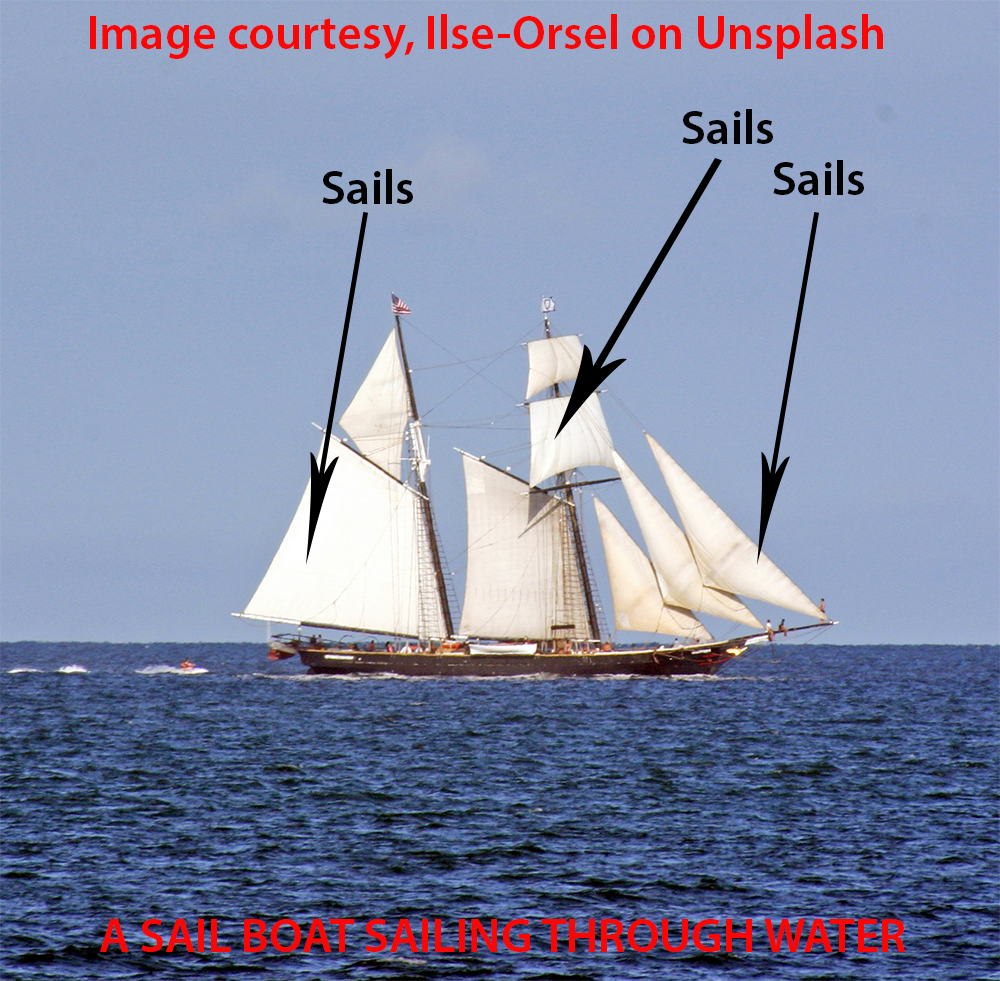
Mast
A mast is a vertical pole normally erected on the centerline of a sailboat. The main purpose of a mast is for mounting and carrying sails, but it also serves other purposes including mounting a lifting device, navigation light, radio aerial, signal lamps, etc. Large boats and ships can have more than one mast (one mast each at forward, aft, and center). View this for more.
Tiller and steering wheel
Both the tiller and steering wheel are connected to the rudder of the boat and are used for steering the boat in water. A tiller is a rod connected to the rudder and can be used to steer the boat. Normally small boats have a tiller and medium and large boats have a steering wheel.
Ballast
Ballast is the weight placed in the hull of a boat and its purpose is to provide stability to the boat (to keep the boat upright). The Ballast of a boat is in the form of a compartment at the bottom of the hull and water can be added or removed from this compartment (to maintain the required ballast). When the boat is sailing, the ballast is below the water level and it neutralizes the effects of weight above the water level. View this YouTube video.
Anchor
An anchor is a typically shaped heavy metal piece tied to a chain or rope. Small boats carry the anchor on the bow part of the boat and large boats and ships will have a pipe or pocket to place the anchor.
When the boat is to be anchored in mid-water, one end of the rope or chain is tied to the anchor, and the other end is tied to the cleat of the boat. The anchor is lowered into the water till it hits the water bed and gets fixed there.
The shape of the anchor used depends upon the kind of water bed at the place of anchoring. The water bed may be rock, sand, loose mud, etc. An anchor secures the boat in place against the forces of wind and tides.
Navigation lights
Navigation lights are the specific color lights on the boat at specific locations on it. Navigation lights make the boat visible to other sailors on the water during the night and enhance the safety of the boat.
Other areas of the boat
A bathroom on a boat is called ‘heads’ and it may be equipped with a toilet, shower, wash basin, etc. The living room on a boat is called a saloon and the facilities in the saloon can include a dining table, relaxing furniture, sleeping bunk beds, etc. Some boats may have a swim platform at their transom for easy exit for swim and entry into the boat after swimming.
Terminologies of boats used by sailors
Water line
With reference to a floating boat or ship, a waterline is defined as the imaginary line where the hull meets the surface of water. The water line separates the wetted parts and dry parts of a boat.
The concept of waterline was invented by Samuel Plimsoll and the waterline marking on the boat/ship helps establish the safe load-carrying capacity of the boat/ship. As the boat/ship is loaded, it goes into the water. The boat/ship is allowed to sink till the water line only.
If you increase the load of the ship, beyond its capacity, the ship may sink and it is dangerous to do it. It is important to maintain the waterline as specified by the boat company and/or local regulators for the safe sailing of the boat.
Freeboard
The freeboard is the distance measured between the waterline and the deck of the boat. The freeboard can vary since the waterline varies according to the load on the boat. For the safety of the boat and its occupants, the freeboard is to be maintained as recommended by the boat manufacturer and overloading of people or goods on the boat should not be allowed.
The waterline and freeboard depend on the water in which the boat is sailing and also the temperature; the water can be river water and seawater, and the temperatures can be cold in winter and hot in summer. The density of water varies depending on the salinity and temperature of the water and the change in density leads to a change in buoyancy of the boat.
Draft
The draft of a boat is its depth below the waterline viz. the depth measured vertically from the waterline to the lowermost point of the hull (the lowermost point can be keel or propeller). The draft of a boat indicates the minimum depth of water in which the boat can safely navigate.
The draft can vary since the waterline changes according to the load on the boat. Refer to the boat manufacturer’s advice on the draft to be maintained.
Beam
The beam is the width of the boat measured at its widest point.
Mooring
A mooring is a permanent or semi-permanent structure or anchoring facility on the water to which the boats can be safely anchored. Mooring includes piers and buoys. The advantages of moorings are they have better holding power compared to a temporary anchor, they are convenient to use, and they are considered less harmful to the marine environment. View this for more.
The direction of boat movement
When the boat is moving in the ahead direction it is said the boat is moving in the forward direction and if the boat is moving backward, it is said the boat is moving in the astern direction.
View this and this YouTube videos for parts of a boat and this YouTube video for parts of a ship.
Propulsion for a boat
A boat needs to be propelled to move forward and the propulsion may be provided by following means.
- Propeller driven by an inboard motor
- Propeller driven by an outboard motor
- Water jet by outboard motor
- Manual propulsion viz. rowing or peddling
- Using wind energy (sailboats)
An outboard motor is popularly used on boats; let us know more about it.
Outboard motor
An outboard motor is a self-contained propulsion system for boats and it is designed for mounting to the exterior of the boat transom. The major parts of an outboard motor are the engine, gearbox, and propeller. The outboard motor provides propulsion as well as steering; the pivoted outboard motor can be steered to change the direction of thrust and make the boat turn.
Outboard motors are a popular mode of propulsion for boats and depending on the size of the boat, 1, 2, or three outboard motors can be fixed on a single boat. In small boats the helmsman can operate the outboard motor using the controls on it and steer the boat using the tiller; in big boats mounted with 2 or 3 outboard motors or a single higher HP outboard motor, the outboard motors can be controlled from the helm through connected cables.
You can tilt an outboard motor upwards, either manually or through cables to avoid hitting the ground when the water level is shallow.
Pump-jet propulsion-type outboard motors are available as an alternative, but their efficiency is less than the propeller-mounted outboard motors.
An outboard motor has many advantages including:
- You can remove outboard motors for storage or maintenance.
- Small outboard motors can be easily removed from one boat and mounted on another.
- Battery-powered outboard motors are available.
Nautical mile and knot
A nautical mile is the unit of length to indicate the distance travelled by a boat or ship through the water and this unit is used for air and space navigation also. The nautical mile may also be used to define the territorial waters of a country.
The nautical mile is based on the longitude and latitude coordinates of the earth and it is defined as the meridian arc length equivalent to one minute or 1/60th degree of latitude at the equator. One international nautical mile is defined as or equal to 1852 meters.
The relationship between a nautical mile and a mile measured on the land is 1 nautical mile = 1.1508 land miles.
The distance on land has two measurements, miles, and kilometers, but the distance traveled through water has only one measurement, nautical mile.
Why the distance traveled through water cannot be measured in miles and kilometers (like the distance on land)?
Sailors and mariners are more conversant with latitude and longitudes and they use nautical charts that use latitude and longitude; so, mariners find it easier to understand and use nautical miles.
A nautical mile is the measure of distance traveled through water and the knot is the speed of travel; one knot=one nautical mile per hour. If the speed of the boat is 15 knots, it means, the boat travels 15 nautical miles in one hour. The term knot came to be used because during the 17th century sailors used a rope with knots at specific regular intervals, to measure the speed of the boat.
Frequently asked questions
What is the difference between a boat and a ship?
Both boats and ships come under the category of watercraft, and the basic construction of a boat and ship have similarities, many terminologies and parts names have the same meaning for both boat and ship. But boats and ships are not the same, and they have major differences as explained below.
- A boat is much smaller compared to a ship. A ship carries boats for emergency use, but a boat cannot carry a ship. In the present naval terminology, a boat is defined as a watercraft that is small enough to be carried aboard ships.
- Boats are normally used on river and lake waters and protected waters. Ships are built for sailing in seas and oceans where the water is wild.
- The purpose of a boat is recreation, transport of humans and goods on a lower scale, fishing, sport, etc. Ships are built for the transport of humans and cargo on a large scale and it travels across seas and oceans.
- A boat and a ship have similar shapes and parts, however, the construction of a ship is more complex and time-consuming; obviously, a ship has many parts that are not there in a boat.
What is the difference between a boat and a raft?
The major difference between a boat and a raft is their construction and how they get their buoyancy to keep floating on water. A boat is constructed using wood, steel, or fiber material and has a hollow hull filled with air. A boat floats on water because the weight of water displaced by it is more than the weight of the boat.
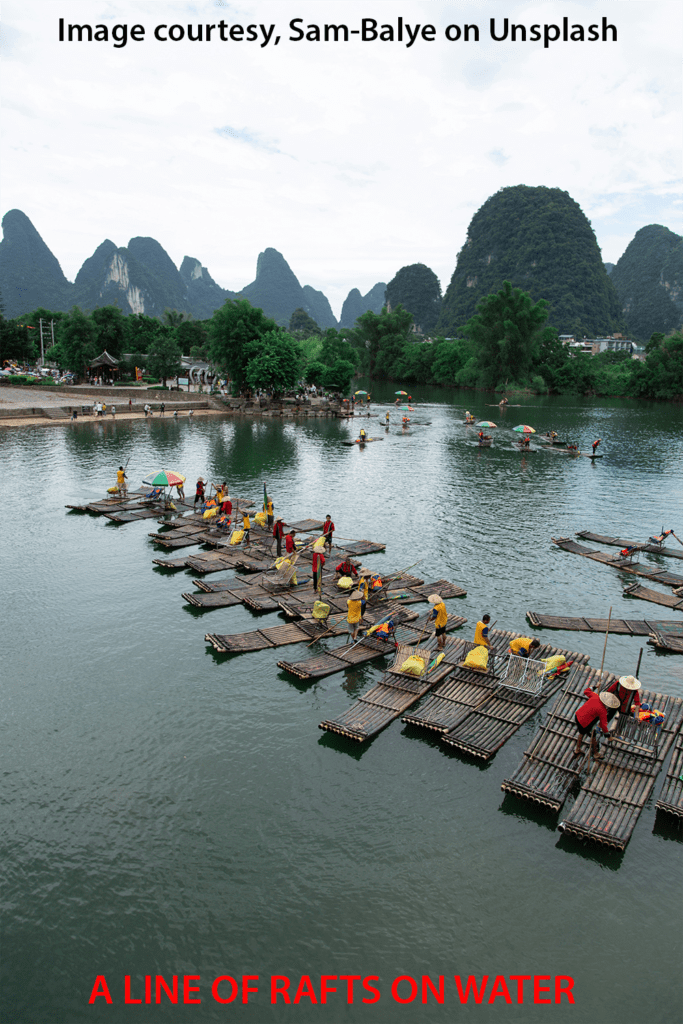
In contrast to the above, a raft is constructed by joining together items that are buoyant themselves and the items used for the construction of a raft are wooden logs, bamboo poles, empty oil drums, inflated hides, etc. Wooden logs and bamboo poles are themselves buoyant because their density is much less than water; empty oil drums and inflated hide are buoyant since they are hollow and filled with air.
Another difference is a boat is constructed for going through the water and can withstand and protect its occupants from rough weather, but a raft exposes its occupants to rough weather and can be used for short distances only (like crossing a short river or lake).
Why a boat sinks in water?
A boat is constructed for floating on water, but we read about incidents of boat capsizing and sinking. Why does a boat sink?
Accidents can happen everywhere, on land, on water, or in the air; but most accidents including capsizing and sinking of boats can be eliminated if and only if all the safety precautions and concerned laws are followed and obeyed.
A boat is buoyant and keeps floating on water as long as the weight of water discharged by it is equal to or more than its own weight. If the boat is overloaded with people or cargo the boat may lose its buoyancy and may capsize.
A boat may encounter a rock or another boat while sailing and this can damage the hull. A hole in the hull can allow water inside and the boat may lose its buoyancy and capsize or sink.
Thirdly, nature may become rough and a boat sailing on rough and turbulent water may not be capable of withstanding it.
Fourthly, a boat involved in an unfortunate incident may not be carrying sufficient safety kits like life jackets, and life buoys to save lives.
If you study the above reasons, it is easy to conclude that most accidents are preventable simply by not overloading, by deploying experienced and expert sailors to man the boat, not venturing into the water when there is a bad weather forecast, and finally by carrying sufficient lifesaving kits onboard.
What materials are used to build boats?
The material used for the construction of a boat can be wood, steel, a combination of wood and steel, aluminum, and non-metals like fiberglass. Aluminum has the advantage of corrosion resistance and high strength-to-weight ratio. Fiberglass boats have good strength, lightweight, and corrosion resistance, but they are vulnerable to higher temperatures and sunlight.
You may read the following articles
How a submarine sinks and floats on water
Conclusion
Knowing the parts of a boat is quite interesting, is it not? Hope this article was of interest to you and answered some of your questions on the boat.
Caution
The only purpose of this article is to share information. The author makes no claims regarding the accuracy or completeness of the content of this article. The intention of this article is to share information and it is not a guide for aspiring boaters. If you are interested in learning boating, please enroll yourself in a government-approved Boating Academy or Institute near you.

